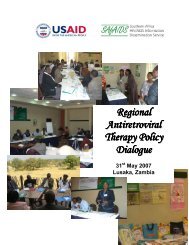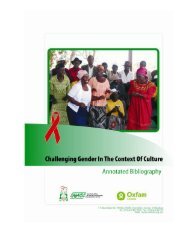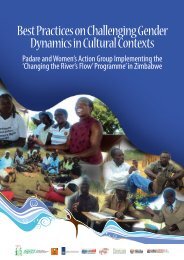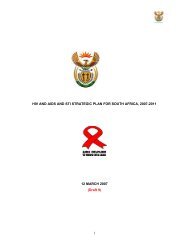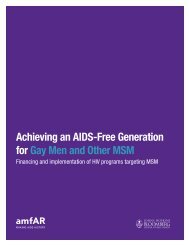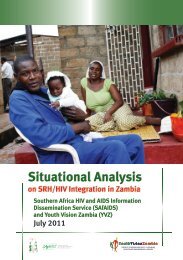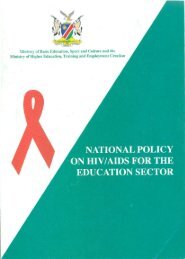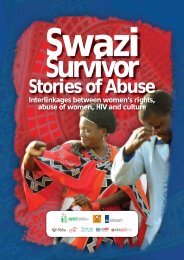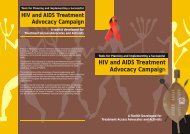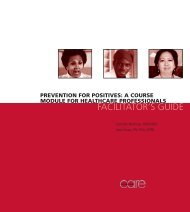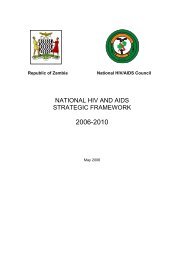Implementation of regional and international HIV prevention - SAfAIDS
Implementation of regional and international HIV prevention - SAfAIDS
Implementation of regional and international HIV prevention - SAfAIDS
- No tags were found...
You also want an ePaper? Increase the reach of your titles
YUMPU automatically turns print PDFs into web optimized ePapers that Google loves.
The number <strong>of</strong> persons with advanced <strong>HIV</strong> infection receiving ART has increased from 39,351in 2005 to 149,199 in 2007. In 2006, a total <strong>of</strong> 80,030 or 32.9% <strong>of</strong> all with advanced <strong>HIV</strong> infectionwere receiving ART while the 149,199 accounted for 50.6% in 2007. However, in terms <strong>of</strong> theprogramme implementation performance according to set targets <strong>of</strong> 90,000 for 2006 was88.9%, while in 2007 a 115% result was attained based on reaching 80% <strong>of</strong> the estimated need<strong>of</strong> 130,000. The scaling-up <strong>of</strong> free ART was continued in 2006, resulting in a significant increasein the numbers <strong>of</strong> centres providing both ARVs for PMTCT <strong>and</strong> ART nationwide, from 62 in2005 to 146 in 2006 <strong>and</strong> 320 at the end <strong>of</strong> 2007. The <strong>HIV</strong> treatment figures reported in theUNGASS report slightly differ from those collected on the UNAIDS site, given below:Table 4: IndicatorsIndicatorsYears2004 2005 2006 2007Number <strong>of</strong> sites providing ART 110 322Number <strong>of</strong> people needing ART 290,000 300,000 310,000 330,000Number <strong>of</strong> people receiving ART 20,000 49,000 82,000 151,000% <strong>of</strong> ART coverage 7 16 26 46WHO/UNAIDS/UNICEF Epidemiological Fact Sheet on <strong>HIV</strong> <strong>and</strong> AIDS Zambia update Report 2008The total number <strong>of</strong> <strong>HIV</strong> infected pregnant women who received ARVs to reduce mother-tochildtransmission increased from 14,071 in 2005 to 25,578 in 2006 <strong>and</strong> by the end <strong>of</strong> 2007,the number had increased to 35,314. Based on an estimated need <strong>of</strong> 86,232 for 2006, thepercentage <strong>of</strong> <strong>HIV</strong> positive pregnant women who received ARVs was 29.7%, while in 2007Zambia increased this proportion to 39.1% based on an estimated need <strong>of</strong> 90,252.The percentage <strong>of</strong> estimated <strong>HIV</strong>-positive <strong>and</strong> TB coinfection cases that received treatment forboth TB <strong>and</strong> <strong>HIV</strong> was 34.8% out <strong>of</strong> a total need <strong>of</strong> 60,723, while in 2007 <strong>of</strong> the 12, 835 (or 66%)TB patients who tested positive for <strong>HIV</strong>, a total <strong>of</strong> 5,017 (or 39%) individuals were started on ART.24Vulnerability to <strong>HIV</strong> among the youth remains high, with only 10.2% <strong>of</strong> young women <strong>and</strong>men aged 15-19 years taking an <strong>HIV</strong> test in the last twelve months <strong>and</strong> knowing their results in2007. This situation was further compounded by the fact that only 33.6% <strong>of</strong> the youths <strong>of</strong> thesame age group were able to correctly identify ways <strong>of</strong> preventing the sexual transmission <strong>of</strong><strong>HIV</strong> <strong>and</strong> who rejected major misconceptions about <strong>HIV</strong> transmission. Youth vulnerability to <strong>HIV</strong>also increased; the proportion <strong>of</strong> 15 to 24 year olds who reported having sexual intercoursebefore the age <strong>of</strong> 15 years rose from 10.3% in 2005 to 14.6% in 2007.Similarly, the percentage <strong>of</strong> most-at-risk populations, classified as sex workers, who received an <strong>HIV</strong>test in the last twelve months <strong>and</strong> knew their results remained low at 17.3% for all sex workers, withthe under 25 year olds scoring 17.9% while those 25 years <strong>and</strong> above scored slightly less at 16.5%.



